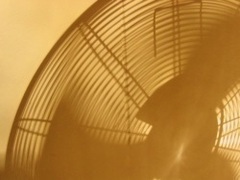Air conditioning vent damper
Updated: 2022-01-17
By Paul Bianchina
Inman News
All of us are looking for ways to conserve energy and stretch our heating and cooling dollars as far as possible. Some often-overlooked problem areas are the home's many small vent dampers, which can account for a significant amount of air leakage if they are not functioning properly.
All of us are looking for ways to conserve energy and stretch our heating and cooling dollars as far as possible. Some often-overlooked problem areas are the home's many small vent dampers, which can account for a significant amount of air leakage if they are not functioning properly.

Every home has a variety of ventilation devices designed to remove moisture and odors from the home and exhaust them to the outside. These include bathroom exhaust fans, kitchen exhaust hoods, clothes dryer vents and a variety of other similar fans and vents. All of them work in pretty much the same manner: A fan motor extracts the air from the room (or from inside the dryer) and pushes the air through a vent pipe to an exterior wall, where it exits to the outside through some type of weatherproof cap arrangement.
Where air can exit, however, it can also enter, and that's where the vent dampers come in. Vent dampers are simply small flaps that are designed to open when a vent is in use and close when it's not. Typically located at the very start or end of the vent pipe, most dampers operate on a very simple, non-powered principle - when air is flowing through the duct, the air movement pushes the damper open to allow the air to exit; when the air flow stops, a small spring pulls the damper back into the closed position to seal the vent pipe off from the outside.
The vent damper is often part of the appliance itself. For example, on most bath fans and kitchen exhaust hoods, the damper is located on the housing of the fan unit, right at the point where the vent pipe attaches to the housing. On other types of appliances, the damper may be located at the exterior vent cap - clothes dryers, for example, have a damper located in the exterior cap where it is less likely to be affected by the dryer's heat. In some fairly uncommon instances, vent dampers may be located at some remote point within the vent pipe itself.
Damper Maintenance
Dampers are one of those little jewels of ingenuity that have almost no moving parts and that will operate trouble-free for many years. But eventually dirt, dust, grease and other byproducts of everyday life can build up and impede the movement. When that happens, the damper will stick in a completely or partially open position, which can restrict airflow through the pipe and allow cold outside air to work back into the house. In extreme cases, the damper can stick closed and restrict the airflow so severely that the fan motor will overheat and possibly catch fire.
If you suspect that a damper may be malfunctioning - you can feel cold air coming in or the fan seems to be making a different noise or seems to be laboring more - it's time to check and possibly repair it.
Step one is to locate the damper mechanism. On bathroom exhaust fans, you will usually need to remove the fan cover, then disconnect and remove the internal fan mechanism to locate the point where the vent meets the fan housing. On kitchen exhaust hoods, the damper is usually on top of or at the rear of the unit, where the exhaust pipe meets the hood. With a clothes dryer, check the outside dryer vent cap where it exits the house.
The typical damper mechanism consists of three parts - the damper itself, which is round or square and is typically made of metal or plastic; the spring that pulls the damper closed and holds it in that position; and a gasket that the damper seals against.
First, make sure you have shut the electrical power to the fan or the dryer. With your fingers, operate the damper flap open and closed and check for smooth operation. If the flap hangs up at all, it could have become bent, or the hinges may be dirty or binding. Try bending the flap gently, and also try cleaning and lightly oiling the hinges. Push the damper completely open and see how well the spring pulls it closed again. Springs can lose their tension over time, and repairing it is often simple a matter of bending the spring slightly to increase tension. Finally, look at the condition of the gasket, and how uniformly the damper flap closes against it - if necessary, clean, reseat or replace the gasket.
If you are unable to repair the damper mechanism, your last resort will be to replace it. Check the model number of the fan or exhaust hood and contact the manufacturer for replacement parts. Clothes dryer vent caps are universal and you can find a replacement one at any home center or hardware store.
Comments (0)
